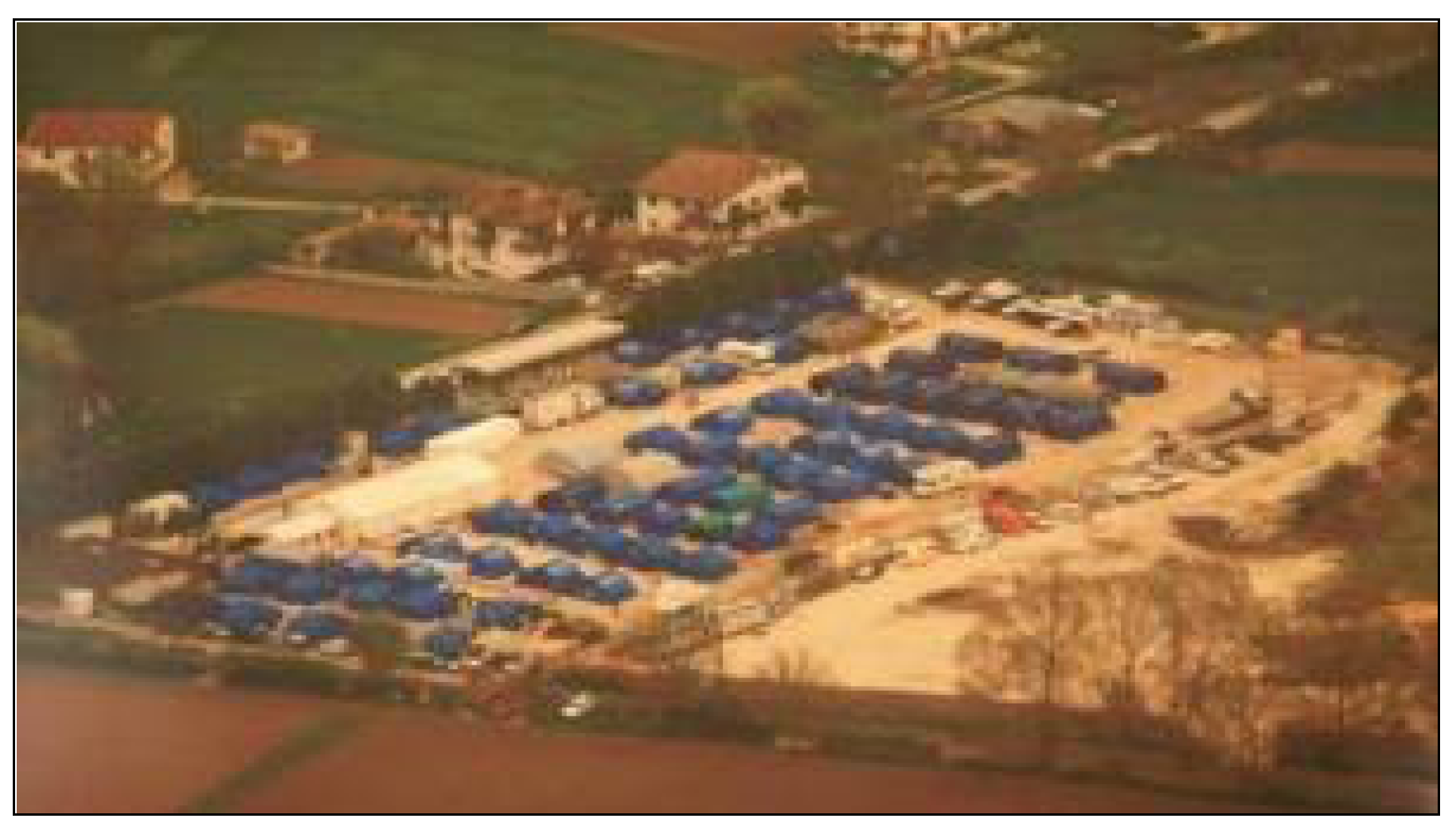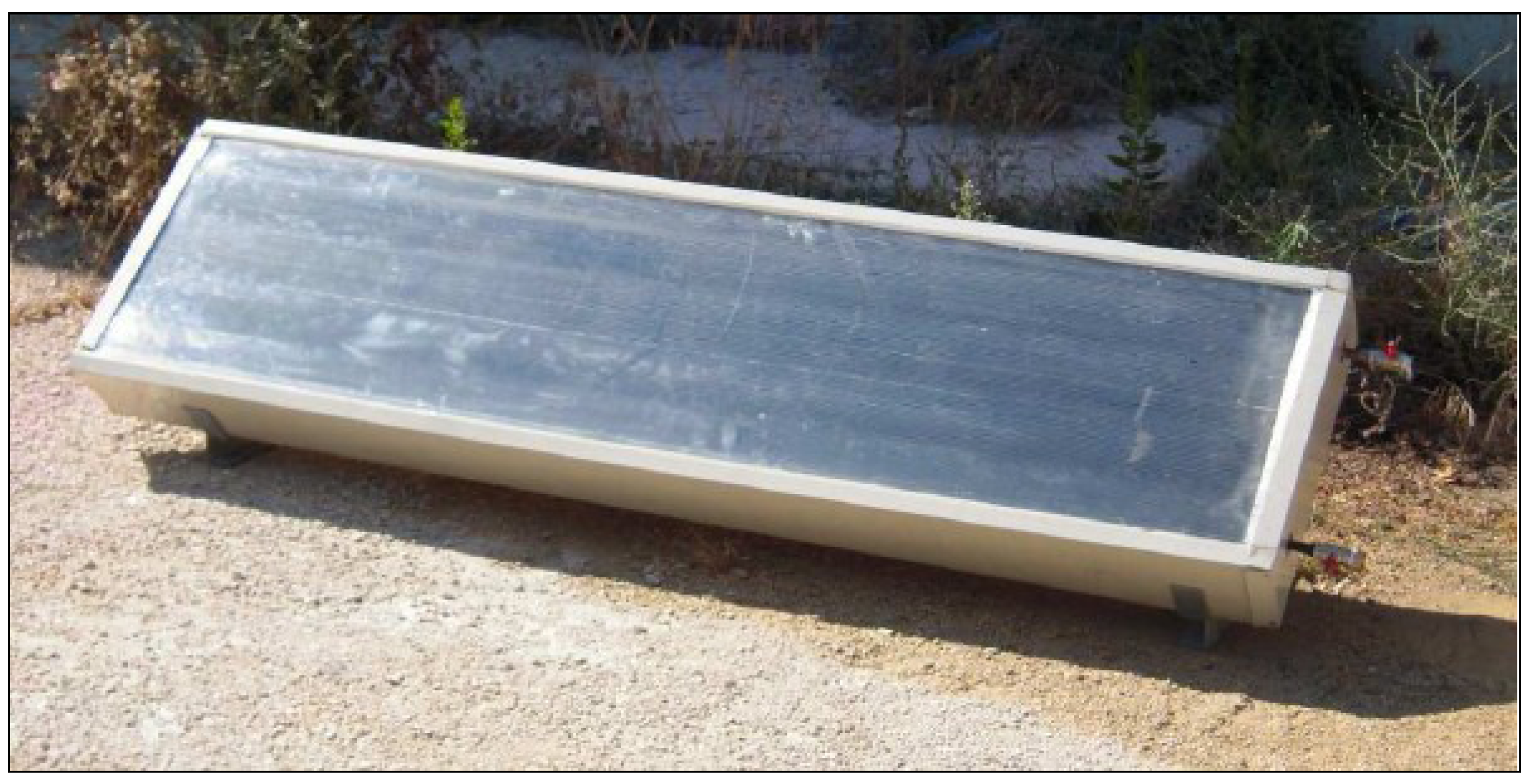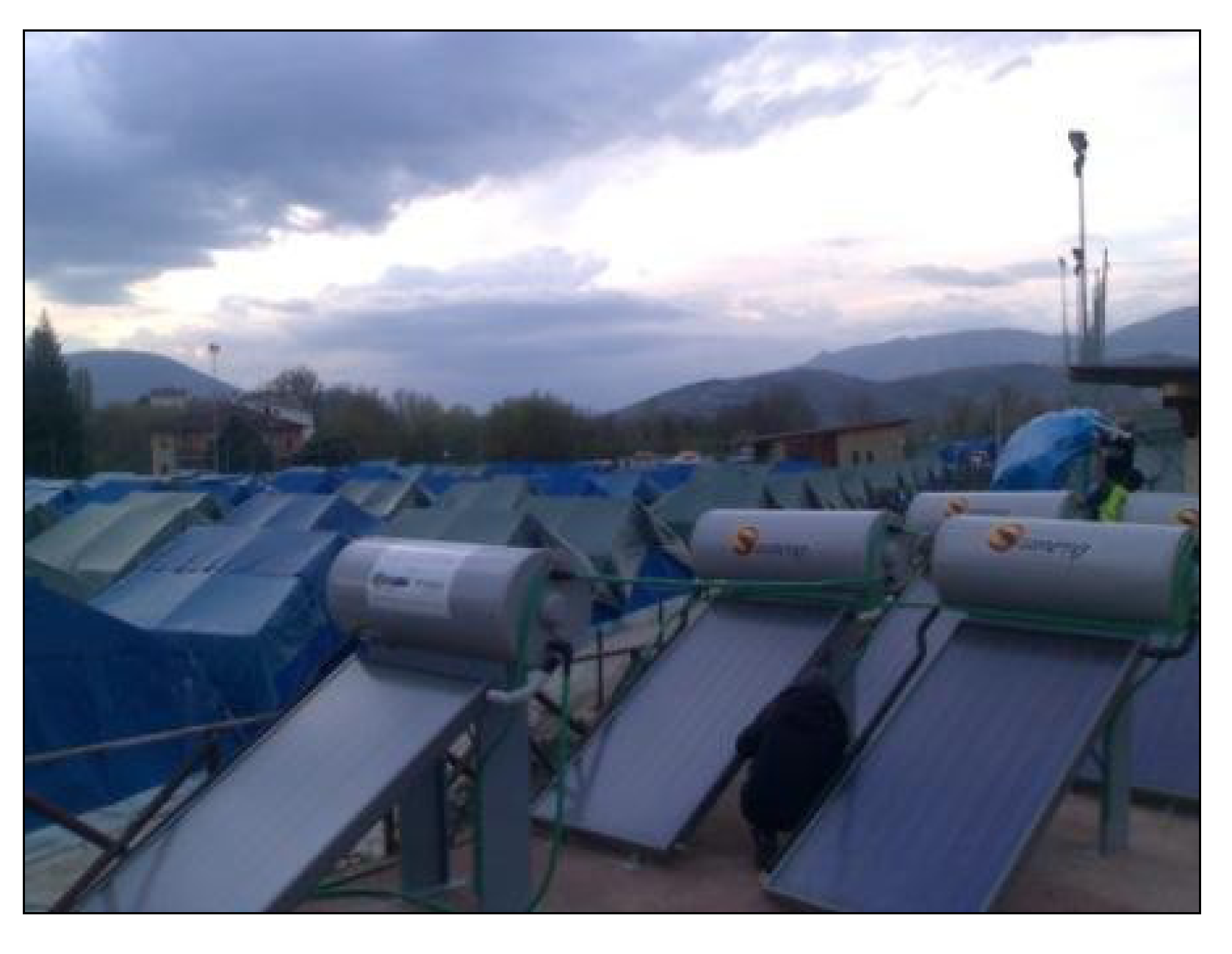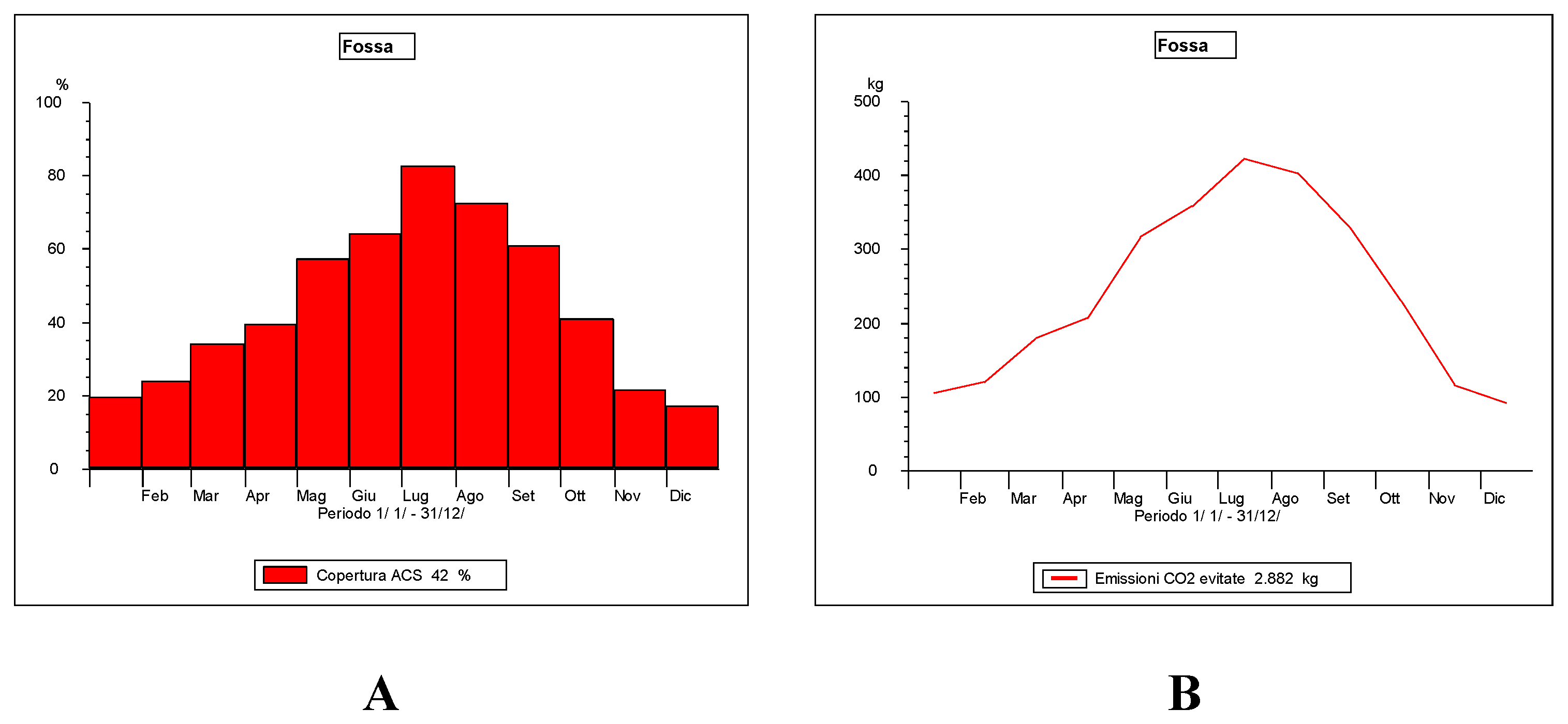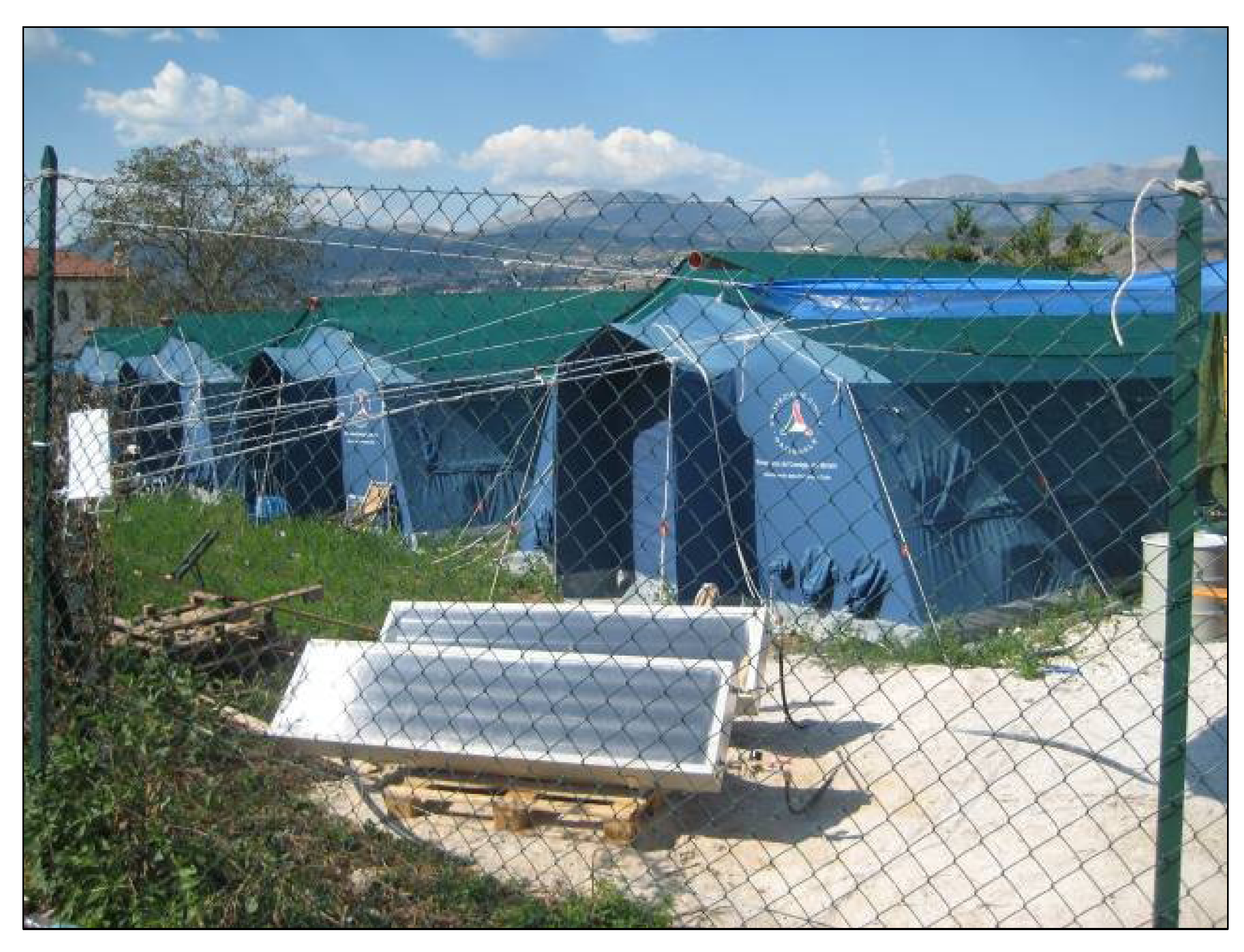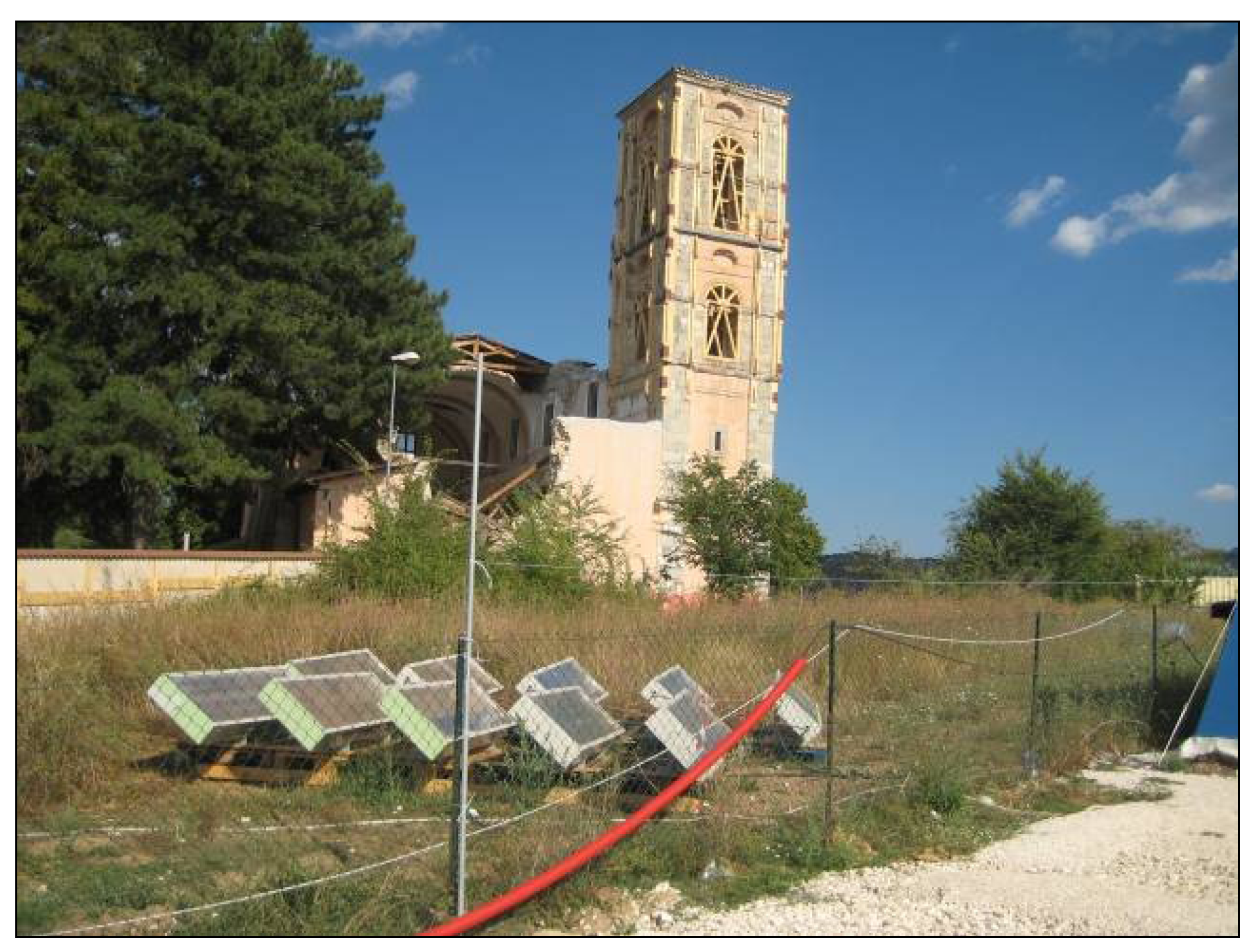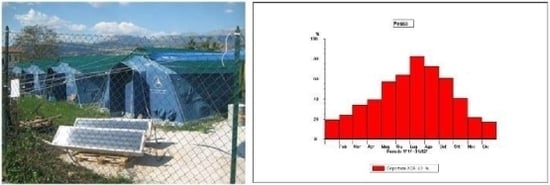1. Introduction
Natural disasters raise technological, economic, societal and environmental issues [
1]. Therefore, after a natural disaster, mitigation measures in the areas of technology, economy, sociology and environment should complement each other in order to rebuild a sustainable community. Although mitigation activities during post-emergency and rehabilitation phases focus on the reconstruction and repair of housing, businesses and other facilities, it is necessary to ensure that the principles of sustainable development are implemented as well [
2]. Berke and Beatley have described the concept of sustainable development, applied in the context of long-term disaster recovery, as the extent to which post-disaster initiatives (1) promote economic development; (2) recognize ecological limits; (3) improve distributional equity; (4) prevent or minimize harm to others; and (5) promote participation [
3]. Concepts of sustainability and sustainable development offer a useful framework for integrating disaster reduction with other social and environmental goals during the recovery phase [
4].
The continuous innovations in renewable energy technologies, particularly in the solar energy field, help the communities get energy self-sufficiency and mitigate the devastating effects of a dramatic disaster, such as an earthquake. The project focuses especially on Domestic Hot Water (DHW) supply and green building design [
5]. The DHW supply consisted of two different phases: the first one was carried out during the post-emergency phase, with the installation of 152.5 m
2 of solar thermal panels in 10 different internally displaced persons (IDP) camps and about 50 m
2 of photovoltaic panels; the second phase of the reconstruction consisted of promoting renewable energy systems for domestic use, taking into account both solar thermal systems and local technicians’ capacities in renewable energy technologies (installation and maintenance) [
6]. In a post-disaster emergency situation, the environmental impact of the temporary settlements is often not recognized, in particular the use of wood and other biomass, as such fuels can be locally devastating [
7]. Energy supplies usually do not rank first in the priority list faced by relief agencies, which tend to focus initially on food, shelter, water and healthcare [
8].
All the difficulties related to energy supply become magnified when people are displaced for long periods—in many cases, for years [
9]. Effective solutions need to consider energy accessibility, such as its sustainable supply and distribution in the vicinity of the camp [
10]. It is also important to ensure that refugee communities are effective participants in projects and activities proposed: the MPT tool (Match Person and Technologies, New York, NY, USA) can be used to assist the project developers in order to achieve the best possible combination between people and technology [
11].
The above mentioned framework for a sustainable long-term disaster recovery action has to be considered. In this direction, sustainable technologies—not only renewable energy systems—should play an important role during the critical days following a disaster. For example: photovoltaic (PV) systems that tap solar energy to generate electricity have provided power during the emergency phase of a number of disasters in USA and Western Sahara [
12,
13]; sustainable water treatment systems had been used both for purification process in Iraq, for appropriate pumping technologies in Kashmir and to produce electricity by a micro-hydro system in Chiapas, Mexico [
14,
15,
16].
This paper analyzes post-earthquake actions undertaken to supply heat and power to the displaced population through renewable energy technologies. This study also intends to re-launch the debate on the standardization of intervention procedures for installing renewable technologies in emergency contexts, in order to identify the most appropriate solutions, provide reliable information to operators and promote the use and knowledge of clean energy production.
2. Methodology
Solar Thermal Technologies represent an efficient and cost effective solution for collecting solar energy received on the ground. In particular the production of domestic hot water constitutes a particularly interesting application of solar energy due to the very simple configuration to be implemented and the general good efficiency of the equipment [
17].
The action has taken place in two different phases: the post-emergency and the reconstruction phases. A participatory approach has been followed during the whole project, starting from the first contact with the local population immediately after the earthquake to the installation of several plants on new buildings.
In the post-emergency phase, a “learning-by-doing” approach has been followed: a speedy humanitarian response requires operators to be duly prepared to start the necessary activities.
The following list of activities was carried out in each IDP camp:
- (1)
Identifying the person belonging to the Italian Civil Protection service (responsible for the energy plants of the camp) in order to carry out the energy problem of the population;
- (2)
Carrying out interviews and field surveys to identify the needs of the IDP and disadvantaged or disabled people, also following the methodology of “ICF Check List” [
18];
- (3)
Designing the plant and preparing a feasibility study to be approved by local population and camp manager;
- (4)
Presenting the project to the community and training local population on the technologies involved;
- (5)
Installing the plant together with trained local people in the previous step and expertise, along with volunteers coming from CSOs.
The
reconstruction phase has provided a strong involvement of the local municipalities, pushing the reconstruction of the cities on the energy sustainability path. The role of local authorities is essential in order to introduce a new way of thinking about energy production: distributed generation and power response to the real needs of the territories. The new emerging paradigm of the energy sustainability is based exactly on this vision: technologies for the social needs of the community. With the perspective of efficiency and rational use of energy,
a participatory approach on economic development issues related to renewable energy is the main vehicle towards the success of any policy and decision-making process at any level also in Solar Thermal Energy Diffusion [
19,
20]. The use of renewable sources in post-emergency situations and reconstruction of areas affected by natural disasters is a boost to the revival of the economic development of territories in a more sustainable direction in terms both of costs and quality of life. The town of L’Aquila is doing a lot to encourage the use of renewable energies in the reconstruction after the earthquake. In fact, it has issued a new building regulation with specific and detailed instructions and requirements in terms of sustainable construction, energy efficiency, bio-architecture and use of renewable sources for new buildings or reconstruction, wholly or partially, of damaged buildings [
21].
In this framework, CIRPS together with the local government and other non-profit organizations decided to launch an open tender, asking the local population to present their own solar thermal project for their new houses. Thanks to a German company, 150 solar thermal panels have been donated to the affected communities of Abruzzi so as to strengthen a sustainable reconstruction. The call for projects “The Sun after the Storm” which closed in mid December 2010, awarded the projects presenting focus on social impact and presenting feasible sustainable energy proposals.
3. The Case Study: Abruzzi Earthquake
On April 6 2009 the Province of L'Aquila in Abruzzi region was seriously damaged by a Mw 6.3 earthquake—see
Figure 1. After the huge earth tremor roughly 1,500 people were injured and it was already clear that more than 30,000 people would have lost their houses [
22]. A week later, the victims totaled 293. In the province the situation was also severe: in Onna town, 50% of houses crumbled away and the remaining 50% was damaged. The effects of the earthquake were devastating, due to the population density in the stricken area. The epicenter was just few kilometers from the center of L’Aquila, a city of about 75,000 inhabitants and important architectural masterpieces in the historical center. Many vulnerable historic buildings were severely damaged or collapsed. Moreover, L’Aquila, being the capital of the Abruzzi Region, also hosts all the main governmental offices of the Region, so that the main public activities were interrupted or spoiled by the collapse of many public buildings.
Soon after the earthquake the Italian National Civil Protection Service was activated to face up the emergency phase, aimed at rescuing as many people as possible and providing a safe shelter to all people. After some days, the problems related to the second phase (post-emergency phase) started to be considered, with the aim to re-establish acceptable life conditions until the third long phase (reconstruction phase) is completed. The three phases are not perfectly sequential, as actually there is some overlapping, in order to immediately meet the needs arising at the end of one phase with the first results or products prepared for the subsequent phase.
Disaster relief aid,
Civil Defence, the volunteers of
Red Cross and the police, in collaboration with many CSOs (
Civil Society Organizations) worked together to help displaced people to rebuild a “normal life”, in around 200 camps.
Figure 1 shows the IDP camp of Fossa (AQ).
Figure 1.
Fossa displaced camp, province of L’Aquila, April 2009 (A. Micangeli).
Figure 1.
Fossa displaced camp, province of L’Aquila, April 2009 (A. Micangeli).
Two different solutions were been set up and realized by Civil Defence and Italian Government, for the reconstruction phase: the projects
C.A.S.E. and
M.A.P. On June 24 2009, the Italian Government passed a special act to finance the rehabilitation of
L’Aquila and its province. The act provides for the rebuilding of houses in the L’Aquila municipality (C.A.S.E. act), supervised by a special committee appointed by the government directly. As to the
province of L’Aquila, the act provides for the rebuilding of 1,500 temporary housing modules (M.A.P. act) directly managed by the municipalities in collaboration with local companies. About the C.A.S.E. project, considerable energy savings were obtained, due to the thermo-insulation characteristics of the building walls and to the renewable energy systems installed: 7,000 m
2 of solar thermal panels and 35,000 m
2 of photovoltaic systems. The total cost of all the action was about 725 million Euros [
23].
Generally in the camps, the energy supply for DHW was given by boilers installed inside the shelters. Due to the large numbers of displaced people refugee in the camps, the hot water supply was not sufficient for everybody: about 20% of people did not have access and the laundry areas were provided just with cold water [
19]. Moreover, the earthquake happened in April so that the population was going to spend the whole summer inside the tents.
In this context the first intervention of CIRPS took place, meeting the requirements coming directly from the displaced population. 15 days after the earthquake, the first solar thermal plant of 20 m
2 was installed in Fossa camp and people could have the necessary hot water to live better their “new” lives—see
Figure 2.
Figure 2.
Solar thermal plant in Fossa (AQ) (Photo: A. Micangeli).
Figure 2.
Solar thermal plant in Fossa (AQ) (Photo: A. Micangeli).
4. Technical Description of CIRPS’ Solar Thermal Prototype
In an emergency situation like the one in L’Aquila, CIRPS, Inter University Research Center on Sustainable Development of “
Sapienza” University of Rome, developed a new low-cost system for supplying thermal energy in emergency situations [
24,
25]. This solar panel (see
Figure 3,
Figure 4) was designed minimizing its cost and reducing installation and maintenance problems, in order to make it suitable in natural disaster situations, or in developing countries.
Figure 3.
ICS integrated collector.
Figure 3.
ICS integrated collector.
Figure 4.
Picture of the ICS developed by Interuniversity Centre of Research on Sustainable Development (A. Micangeli).
Figure 4.
Picture of the ICS developed by Interuniversity Centre of Research on Sustainable Development (A. Micangeli).
Its particular characteristic is that the same device serves as a collector as well as for storage. So, it has principally two advantages over the conventional systems with separate units: it has no need for any kind of external tank and it presents no electronic devices.
Solar thermal systems, in which the same device serves as a collector as well as for storage, have an obvious advantage over the conventional systems with separate units. Such systems are referred to as integrated collector-storage systems (ICS). A total of 15.5 m
2 (of this kind of solar thermal panels were installed in eight different camps (
Figure 5 shows a plant in Lilletta camp).
Figure 5.
Integrated collector-storage systems (ICS) Solar thermal plant in Lilletta camp.
Figure 5.
Integrated collector-storage systems (ICS) Solar thermal plant in Lilletta camp.
The state-of-the-art modeling of solar collectors (EN 12975-2) is based on equations describing the thermal behavior of the collectors by characterizing the physical phenomena, e.g., transmission of irradiance through transparent covers, absorption of irradiance by the absorber, temperature dependent heat losses and others, leading to parameters, e.g., the zero-loss collector efficiency η
0 or the heat loss coefficients, this is the case of collectors that cannot be modeled with the same accuracy than conventional collectors [
26].
This innovative solar thermal panel is composed of four thin stainless steel tubes, black primed, with a capacity of 22.5 litre each. Stainless steel does not affect the water potability, making it an appropriate material for storage. Its thickness has been also calculated to make it as thin as possible. This gives an obvious advantage: less steel mass, so it can be transported easier and economically. However, a most important consequence is that a lower mass results in a faster warming, which increases system efficiency.
The tubes are integrated in an isolated aluminium case, with a transparent alveolar polycarbonate cover on top, that permit the solar radiation get in, and warm up the system. The back and sides are isolated using aluminized neoprene and expanded polystyrene layers. Placed between the aluminium case and the tubes, this neoprene layers are hydrophobic, so they are not affected by humidity. Moreover, they both present low conductivity coefficients. The alveolar polycarbonate cover generates a greenhouse effect, which increases the efficiency of the system. It sends the reflection emitted by the tube back to it, minimizing radiation loses to the outside.
This collector is directly connected to the drinking water network, when a user opens the water circuit, cold water from the network travels into the collector, forcing hot water out.
In the past 5 years the efficiency of this kind of collector has been increased, according to numerical studies. The numerical simulation of the thermodynamic processes that occur during the discharging phase stated that the mix of water in the pipes had to be streamlined.
Cold water travelling in when opening the tap and the water heated up by sun irradiation and stored in the same pipe had to be correctly administrate in order to take advantage of the evident stratification of the heat. The result of this analysis brought to a geometrical change of each connection between pipes [
27].
After the geometrical improvements, the average efficiency of the ICS CIRPS’ prototype, calculated in nine experimental analysis in Italian summer conditions (1,000 W/m2, 25 °C), reached 68.92%.
5. Results and Discussion
Aside from the plants utilizing the solar thermal panel prototype developed in CIRPS laboratories (fourth paragraph), in the post-emergency phase another three plants were installed (utilizing commercial panels).
The first commercial system installed was at Fossa camp. It is a 22 m2 plant, comprising 11 flat solar collectors, series connected in two rows: one consists of five panels and the other one of six panels.
Figure 6A indicates the percentage of DHW warmed by the solar plant and utilized in the IDP camp of Fossa (for each month). During the most productive month (July) the installed plant covered 80% of the total DHW needs of the camp; the average of this percentage is 42%. The CO
2 saved with this plant rises up to 400 Kg for the same period (
Figure 6B), evaluated by the T-Sol commercial software methodology [
4,
17,
28].
Figure 6.
Domestic Hot Water (DHW) production and CO2 kg saved with the installed solar thermal plant in Fossa [source: Software simulation].
Figure 6.
Domestic Hot Water (DHW) production and CO2 kg saved with the installed solar thermal plant in Fossa [source: Software simulation].
In
Coppito camp, the second commercial plant was installed: a natural circulation system composed of five collectors, supplying DHW to the shower and the kitchen, as shown in
Figure 7.
Figure 7.
Solar thermal plant in Coppito camp.
Figure 7.
Solar thermal plant in Coppito camp.
In Pizzoli the third commercial plant was installed: A 50 m
2 photovoltaic plant (
Figure 8).
The authors of this article decided to marginally mention this installation, although the lead technology utilized in the project described in this article is the solar thermal for domestic hot water, because of the big size of this solar plant.
In the reconstruction phase, collaboration with local municipalities started. A lot of participatory proposals for a more sustainable reconstruction of Abruzzi region have been presented since the dramatic event, and CIRPS decided to be on the municipalities’ side to push for a sustainable energy reconstruction. The ongoing collaboration between universities, public local bodies and environmental associations on renewable energy issues made the town of L’Aquila an experimental laboratory of study and application of renewable technologies in post-emergency contexts.
For those reasons the “Sun after the Storm” tender was launched on July 2010.
Figure 8.
Photovoltaic plant in Pizzoli camp.
Figure 8.
Photovoltaic plant in Pizzoli camp.
The tender has to be seen in the framework of many other activities implemented by CIRPS after the earthquake and directed to deal with energy supply problems in the emergency, with affected population awareness of a more sustainable reconstruction and the cooperation between all relevant local actors in order to promote an institutional and political environment fitted for the purpose. One hundred and fifty solar thermal panels have been donated to the affected communities of Abruzzi.
Three main groups responded to the call:
- (1)
Public bodies and Non-Profit Organization
- (2)
Small and Medium Enterprises and Rural firms
- (3)
Private People
Participation was possible on an individual basis or by forming a partnership and every winner had to subscribe to a statement declaring his/her commitment to complete the installation within one year from the delivery of the collectors. This measure aims at improving the sense of responsibility, the sustainability of the action implemented and the 21 monitoring process.
The results of the tender were fully satisfactory. All the collectors were assigned. A total of 16 projects were presented, 12 came from private citizens for the production of DHW and in six cases as integration to existing heating systems. The range of panels requested was from two to eight and they were employed mainly for the rehabilitation of buildings hit by the quake or in the construction of new passive building together with other interventions in terms of energy efficiency and production.
This percentage is a demonstration of how Solar Thermal systems fit with the concept of distributed generation, because of its technological maturity and its reliability in covering the needs of DHW and heating, leading to real savings for households.
Two projects were presented by Public bodies and Non- Profit organizations. They have a high social content and aim at rehabilitating symbolic places for social relations, the absence of which is one of the main perceived problems among the people of L’Aquila. In this case, the number of panels requested was 10 for each project. The results of the tender underline the need to facilitate stakeholders to apply for projects concerning renewable energies from the moment that they act in the name of the public and social good and can benefit a large number of people.
The remaining two projects were presented by Small and Medium Enterprises (SMEs) and rural firms: the collectors will be employed to produce DHW in a small hotel and for cleaning working tools. Each project asked for six panels. Even in this category, the possibility to act to promote the use of renewable energies in the hotel and rural sector demonstrates that such an intervention could lead to energy savings and to the improvement of marketing activities.
An interesting observation is that none of the projects was presented in partnership, as suggested in the Call for proposal. The intention of the promoters of the tender was to foster not only money saving but also a social tool in order to verify if the association with others could lead to a wider diffusion of the Call and to a wider impact on local scale. All the presenters were well informed about the opportunities of renewable energy technologies and many of them decided to invest only after the “incentive” of acquiring the panel for free, which halved the cost of installation. This demonstrates how useful ad hoc incentives are and how public investments in this direction can generate jobs and enterprise at a local level. In fact, following the Call for proposal, a firm owned by young engineers—the Green Eagle srl—was born and is building its start-up on the assigned projects in the framework of “The Sun after the Storm” tender.
6. Conclusions
In post-emergency and reconstruction situations, when new buildings, houses and infrastructures have to be rebuilt, the use of renewable energies is seen as a good choice and it can simplify the work done at normative and political level to encourage and boost this tendency.
After the earthquake that hit the L’Aquila Province, in Abruzzi region (Italy), CIRPS along with local municipalities and non-profit organizations began a sustainable energy project,
Figure 9, that was implemented during the post-emergency and reconstruction phases.
Regarding the post-emergency phase, 10 solar systems were installed in camps: 47.5 m2 of solar thermal and 50 m2 of photovoltaic systems, during 6 months of activities.
Figure 9.
Thermal solar plant in Santa Rufina camp.
Figure 9.
Thermal solar plant in Santa Rufina camp.
This work was carried out with volunteers coming from CIRPS together with people living in the camps such as plumbers or solar system installers. In this phase, the project’s aim was to get as many camps as possible energetically self-sufficient, installing plants for all the energy needs in terms of hot water. A participatory approach was applied during this phase, involving local people to identify the energy needs and to design the plant. A lot of requests came, underlining how renewable energies can be an effective solution for post-disaster situation. A long road has to be followed yet, to create standard procedures for the installation of sustainable energy systems of national interventions in post-disaster recovery.
In the reconstruction phase, a tender to assign solar thermal panels was launched by CIRPS, along with local municipalities and Non-Profit organizations.
“The Sun after the Storm” call has highlighted the opportunities and critical issues related to the development of solar thermal systems which can be found at European and International levels. In fact, Solar Thermal was mainly applied to residential uses and it is more difficult to become attractive for the corporate sector, agricultural cooperatives and public bodies [
29]. To develop the high potential of Solar Thermal, politically effective and efficient measures are needed to address and create a suitable environment for investments [
30]. The results of the tender revealed how important the involvement of all relevant stakeholders is in the decision-making process. The aim and structure of the tender was built on real needs and took into consideration all the interrelations among citizens, public bodies, enterprises and academy.
Key elements will be the planning and coordination between different levels of decision making, access to the network, a redefinition of the energy market, training and information, as well as substantial consumer awareness. The importance of efficiency and effectiveness of the level of return in terms of investments in renewable energy must be emphasized. In fact, the field of renewable heat production suffers from a severe lack of accessible data [
31,
32]. This is a consequence of the fact that it has not been examined sufficiently by policy-makers in designing policies and incentives. Although training is typically viewed as “strictly a means to transmit information and skills”, in Abruzzi earth quake it has been “a rare opportunity to have an open policy dialogue “from different institutions and environment policymakers [
33]. An adaptive systems approach would enable decision-makers to evaluate renewable energy systems for sustainability in a participatory, transparent, timely, and informed manner.
